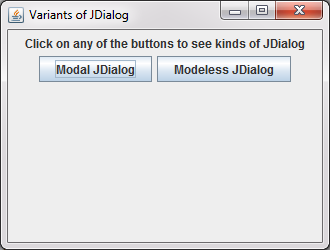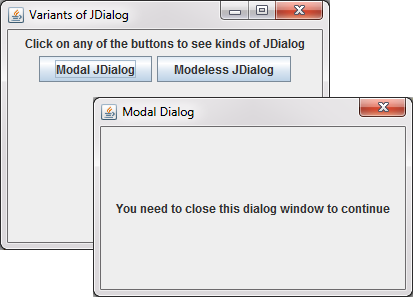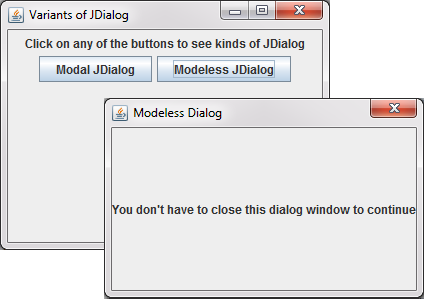Advertisement
| Constructor | Description |
|---|---|
| public JDialog() | Creates a modeless JDialog window without a Frame owner or title. |
| public JDialog(Dialog owner, String title) | Creates a modeless JDialog window with a Frame owner and a title. |
| public JDialog(Dialog owner, String title, boolean modal) | Creates a JDialog window with a Frame owner, title and let's you define modality of JDialog window. |
Advertisement
import javax.swing.*;
import java.awt.*;
import java.awt.event.*;
public class Dialog2
{
public static void main(String... ar)
{
SwingUtilities.invokeLater(new Runnable() {
public void run()
{
new A();
}
});
}//Closing the main method
}//Closing the class Combo
class A implements ActionListener
{
JFrame jf;
JLabel label1;
JTextField field1;
JButton button1, button2, button3;
JDialog d1, d2, d3;
A()
{
jf = new JFrame("JDialog");
button1 = new JButton("Modal JDialog");
button2 = new JButton("Modeless JDialog");
label1 = new JLabel("Click on any of the buttons for a surprise");
button1.addActionListener(this);
button2.addActionListener(this);
jf.add(label1);
jf.add(button1);
jf.add(button2);
jf.pack();
jf.setLayout(new FlowLayout());
jf.setSize(330,250);
jf.setVisible(true);
}
public void actionPerformed(ActionEvent ae)
{
if(ae.getActionCommand().equals("Modal JDialog"))
{
//Creating a non-modeless blocking JDialog
d1= new JDialog(jf,"Modal Dialog",true);
JLabel label= new JLabel("You first need to close this dialog window to continue");
d1.add(label);
d1.pack();
d1.setLocationRelativeTo(jf);
d1.setLocation(new Point(100,100));
d1.setSize(320,200);
d1.setVisible(true);
}
if(ae.getActionCommand().equals("Modeless JDialog"))
{
//Creating a modeless JDialog which doesn't block the
d2= new JDialog(jf,"Modeless Dialog");
JLabel label= new JLabel("You don't have to close this dialog window to continue");
d2.add(label);
d2.pack();
d2.setLocationRelativeTo(jf);
d2.setLocation(new Point(100,100));
d2.setSize(320,200);
d2.setVisible(true);
}
}
}
 Figure 1
Figure 1  Figure 2
Figure 2  Figure 3
Figure 3
Advertisement
Advertisement
Please check our latest addition
C#, PYTHON and DJANGO
Advertisement